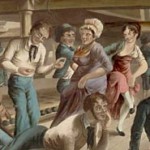 During the period of time Britain claims to have ruled the seas, women played a role that has been largely overlooked or dismissed by most historians and novelists (except for the lewd fantasies of Dewey Lambdin who writes of them as sex objects in salty historical soft porn for guys.)
During the period of time Britain claims to have ruled the seas, women played a role that has been largely overlooked or dismissed by most historians and novelists (except for the lewd fantasies of Dewey Lambdin who writes of them as sex objects in salty historical soft porn for guys.)
Two notable exceptions are historical naval fiction authors, Tom Grundner, who wrote the Sir Sidney Smith series, and Alaric Bond who writes the acclaimed Fighting Sail series. One reason these books appeal to me is that the authors write about women as real people, believable characters who were part of the ship.
Knowing of my interest in women aboard ships in the age of sail, British historian Roy Adkins referred me to Margarette Lincoln’s book, Naval Wives & Mistresses; 1750-1815 (National Maritime Museum Publishing 2007). Roy wrote to me,
…Naval Wives & Mistresses (2007) by Margarette Lincoln is up to date and very well referenced. Some of the conclusions she draws aren’t what I might say, but this is a matter of emphasis not error. The real advantage of the book is that Lincoln was (?still is) Deputy Director of the National Maritime Museum at Greenwich. Consequently she draws heavily on the archive material in that Museum (aka Caird library and archive)…
In my writing I am mostly concerned with the women who actually went to sea, especially the women of the lower decks: The wives of warrant officers and the wives and girlfriends who were aboard illicitly and in numbers impossible to determine. Margarette Lincoln expands the subject to include the lives of the women connected to, and dependent on seamen. Shall I also say that the seamen were dependent in varying degrees to the women in their lives, whether aboard ship or not? The best of these wives handled their affairs while they were gone, gave birth to, and reared their children, kept in touch with their husbands through letters, and gave their emotional support, welcoming their husbands when they returned home. Of course not all wives were so exemplary, and the wives of the men of the lower deck were much more disadvantaged, economically.
Life for naval wives was unpredictable. “For all naval wives,” writes Lincoln, “the outcome of their husband’s career and therefore their own future was something of a lottery.”
My aunt Donny was a 20th century American Navy wife, and is a 21st century American Navy widow. While her husband, Commander Hoke Daniel Griffin was alive, she accompanied him on his various assignments and of late I have been following her on Pinterest. I’m thinking I would like to know more about what it is to be a navy wife, in any century. They also serve who only raise kids, keep house, and offer their love, advice and support. Wives have their stories too.

 Barbados Bound and Surgeon’s Mate; book two of the Patricia MacPherson Nautical Adventure Series tell the fictional 18th century memoir of a young woman who is searching for her place in the world and finds it aboard ship, doing a man’s job. Based on documented accounts of women who served in the British navy, marines, and army, disguised as men.
Barbados Bound and Surgeon’s Mate; book two of the Patricia MacPherson Nautical Adventure Series tell the fictional 18th century memoir of a young woman who is searching for her place in the world and finds it aboard ship, doing a man’s job. Based on documented accounts of women who served in the British navy, marines, and army, disguised as men.